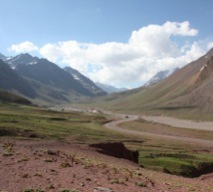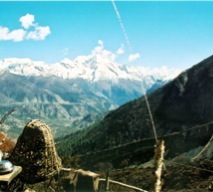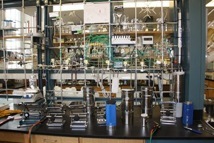Katharine Huntington, nee Ruhl
ASSOCIATE professor
university of washington - department of Earth & Space sciences

Katharine Huntington, nee Ruhl
ASSOCIATE professor
university of washington - department of Earth & Space sciences
RESEARCH
Reconstructing Earth-surface paleo-temperatures on continents is important for studying the evolution of life, climate, tectonics and landforms. We use carbonate clumped isotope thermometry to reconstruct temperatures of ancient lakes and soils and develop new approaches to determine the relative contribution of climate change and elevation change to the temperature record, providing a basis for interpreting temperatures recorded by ancient deposits in the western US (Colorado Plateau), Tibet (Nima and Zhada basins), and the Andes (Puna plateau and Angastaco basin).
Publications: Huntington et al., 2010 (Tectonics)
Huntington et al., 2011 (J Sedimentary Research); Huntington et al. (in press 2014, GSAB); Carrapa et al. (2014, Tectonics); Quade et al. (in press 2014, GSA Special Paper); Huntington & Lechler (submitted, Tectonophysics Invited Review)

Terrestrial paleoclimate and paleoelevation from carbonate clumped isotope thermometry

This research focuses on developing methods of inverting geometric and grain size data from sedimentary deposits to quantify the flow conditions under which they were deposited. Such methods can be applied to a variety of flows that are difficult to observe directly or model in the laboratory, providing quantitative information about ancient depositional environments.
Publications: Huntington et al., 2007 (EOS)
inferring flow conditions from sedimentary deposits:
turbidity currents, tsunamis & floods
Funding: NSF CAREER Award (NSF-EAR 0955309)
This project investigates Himalayan tectonics using bedrock thermochronology and the detrital record preserved downstream of the Eastern Himalayan Syntaxis. The primary research objectives are to determine 1) how focused rapid exhumation at the syntaxis has been, 2) how long it has persisted, and 3) its impact on the sedimentary record of orogenesis.
Educational components: ESS 595, UW in the High School
Publications: Adlakha et al., 2012 (Tectonophysics)
Lang et al., 2013 (Geology); Lang & Huntington, 2014 (EPSL)

Detrital record of focused Exhumation & erosion,
NE Indian Himalaya

Funding: American Chemical Society PRF Grant #49704
This project involves a the application of clumped isotope thermometry to determine temperature of crystallization for diagenetic carbonate. We combine clumped isotope data, petrographic analysis, CL microscopy, oxygen isotopic analysis, and models of fluid-rock interaction to investigate burial diagenesis on the Colorado Plateau and structural diagenesis in the Paradox Basin, UT.
Project featured in ACS-PRF report on research:
http://acswebcontent.acs.org/prfar/2011/media/huntington.html
Publications: Huntington et al., 2011 (J Sedimentary Res.)
Budd et al., 2013 (2013, J Sedimentary Res.)
Bergman et al., 2013 (Amer. J. Science)
Huntington et al., 2014 in press (GSA Bulletin)
Quade et al., 2014 in press (GSA Special Paper)
Huntington & Lechler, submitted (Tectonophys., Invited Review)
Use of clumped isotope thermometry to quantify temperatures of burial and diagenesis

Funding:
NSF Grant EAR-1252064
Quaternary Research Center
Clumped isotopes in carbonate-bearing paleosols hold great potential to quantify environmental change in the deep geologic past. We are investigating the relationship between environmental conditions and temperatures recorded by clumped isotopes in modern soils in the Andes. Are most recent projects are targeting loess deposits in the Palouse region of eastern Washington, the Andes, and the Chinese loess plateau.
Publications: Peters et al., 2013 (EPSL)
clumped isotope thermometry of soil carbonates as a proxy for past cliMate & elevation
This project investigates the erosion and incision history of the Three Rivers Region (TRR) in western China over a broad range of timescales. We use sediment discharge data and cosmogenic radionuclide studies of modern river detritus to (1) test conflicting hypotheses for temporal variations in erosion in the TRR in response to Tibetan Plateau growth, (2) investigate the concept of effective discharge in monsoon regions, and (3) document the impact of recent development activities on erosion.
Publications: Henck et al., 2010 (Geology)
Henck et al., 2011 (EPSL)
Schmidt et al., 2011 (Annals Assoc. Amer. Geographers)

geomorphic evolution of the three rivers region, china
This project focuses on documenting erosion rates and patterns of faulting in the Nepal Himalaya in order to test the hypothesis that climatically driven erosion has focused deformation along the Himalayan front through time. The work integrates 40Ar/39Ar thermochronology, thermal-kinematic numerical modeling, geomorphology, and structural geology approaches.
Publications: Hodges et al., 2004 (EPSL)
Ruhl & Hodges, 2005 (Tectonics)
Huntington & Hodges, 2006 (JGR)
Huntington et al., 2006 (EPSL)
Huntington et al., 2007 (Tectonics)

erosion, deformation & climate in the nepal Himalaya
Some of this material is based upon work supported by the National Science Foundation under Grants EAR-0955309 and EAR-1156134. Any opinions, findings, and conclusions or recommendations expressed in this material are those of the author(s) and do not necessarily reflect the views of the National Science Foundation.
CLumped isotope LABORATORY & Methods DEVELOPMENT
Funding:
Royalty Research Fund Grant 65-2771
National Science Foundation Grant EAR-1156134
We built an off-line clumped isotopes prep line (stainless automated line with autosampler, plus manual glass vacuum line) in IsoLab in the Department of Earth and Space Sciences at UW. A mass spectrometer for measuring clumped isotopologues of CO2 (Thermo MAT 253) was installed in November 2012. Email Kate if you want to collaborate!
Publications: Huntington et al., 2009 (J Mass. Spec.); Huntington & Lechler, submitted (Tectonophys, Invited Review)

impact of Glacial megafloods on erosion of the Tsangpo gorge, eastern Himalaya-tibet
Funding:
National Science Foundation Grant EAR-1349279
This project investigates the history, hydraulics, and erosional impact of prehistoric megafloods in the eastern Himalaya, with the goal of understanding how rugged mountain topography influences flood flows and hazard, mechanisms of landslide triggering and erosion during floods, and the role of extreme events in long-term river incision.
Publications: Lang et al., 2013 (Geology)
